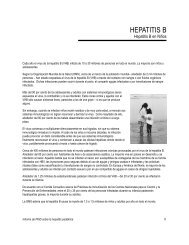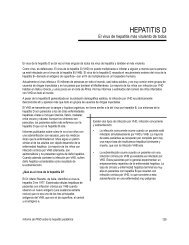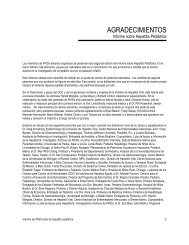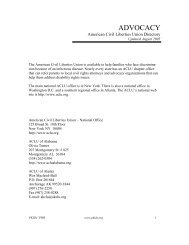Milk Thistle: Effects on Liver Disease and Cirrhosis - Parents of Kids ...
Milk Thistle: Effects on Liver Disease and Cirrhosis - Parents of Kids ...
Milk Thistle: Effects on Liver Disease and Cirrhosis - Parents of Kids ...
Create successful ePaper yourself
Turn your PDF publications into a flip-book with our unique Google optimized e-Paper software.
than st<strong>and</strong>ardized silymarin after oral ingesti<strong>on</strong> in normal volunteers, cirrhotics, <strong>and</strong> patients<br />
after cholecystectomy. 9,25-28 The bioavailability <strong>of</strong> silybin in Silipide ® is approximately tenfold<br />
greater than the silybin c<strong>on</strong>tent <strong>of</strong> st<strong>and</strong>ard milk thistle preparati<strong>on</strong>s. 5<br />
Various methods have been developed to identify the c<strong>on</strong>stituents <strong>of</strong> silymarin, including<br />
thin-layer chromatography (TLC), high-performance liquid chromatography (HPLC),<br />
colorimetry, <strong>and</strong> electrophoresis. 18,29-34 There are two species <strong>of</strong> the silymarin plant: S.<br />
marianum (L.) Gaertn. <strong>and</strong> S. eburneum Coss. Dur. Of the S. marianum species, there are two<br />
varieties: the comm<strong>on</strong> purple flower <strong>and</strong> the much less comm<strong>on</strong> white flower. HPLC can<br />
distinguish between the two species. 28 There are also two chemotypes for the purple variety,<br />
which can be distinguished by TLC <strong>and</strong> HPLC. One has a relatively high silybin c<strong>on</strong>tent <strong>and</strong> a<br />
high silybin:silydianin ratio. The other has a relatively high silydianin c<strong>on</strong>tent <strong>and</strong> low<br />
silybin:silydianin ratio. They appear to be stable chemotypes with characteristic silybin <strong>and</strong><br />
silydianin c<strong>on</strong>tents <strong>and</strong> proporti<strong>on</strong>s for several generati<strong>on</strong>s under the same field c<strong>on</strong>diti<strong>on</strong>s. 28 In<br />
summary, chromatography can thus far distinguish four biochemical pr<strong>of</strong>iles: three for S.<br />
marianum <strong>and</strong> <strong>on</strong>e for S. eburneum. Differences are smaller between S. marianum <strong>and</strong> S.<br />
eburneum than between the white <strong>and</strong> purple varieties <strong>of</strong> S. marianum.<br />
Mechanisms <strong>of</strong> <str<strong>on</strong>g>Milk</str<strong>on</strong>g> <str<strong>on</strong>g>Thistle</str<strong>on</strong>g><br />
Currently, milk thistle (silymarin, silybin, <strong>and</strong> Silipide ® ) is primarily advocated as a<br />
therapeutic <strong>and</strong> hepatoprotective agent, especially in the settings <strong>of</strong> cirrhosis, chr<strong>on</strong>ic hepatitis,<br />
alcohol c<strong>on</strong>sumpti<strong>on</strong>, <strong>and</strong> envir<strong>on</strong>mental toxin exposure. Silymarin, silybin, <strong>and</strong> Silipide ® have<br />
multiple mechanisms <strong>of</strong> acti<strong>on</strong> that may be hepatoprotective, including antioxidant activity, toxin<br />
blockade, enhanced protein synthesis, <strong>and</strong> antifibrotic activity.<br />
Antioxidant Activity<br />
Silymarin is thought to have antioxidant activity in the liver, as well as the small intestine<br />
<strong>and</strong> stomach. As an antioxidant, this compound may reduce free radical producti<strong>on</strong> <strong>and</strong> lipid<br />
peroxidati<strong>on</strong> in the setting <strong>of</strong> hepatotoxicity. Lipid peroxidati<strong>on</strong> is the end result <strong>of</strong> unstable free<br />
radicals’ damage to membrane lipids. These membranes c<strong>on</strong>tain fatty acids that are transformed<br />
to lipoperoxidases, peroxides, <strong>and</strong> lipidic hydroperoxides. Mal<strong>on</strong>dialdehyde is a biproduct <strong>of</strong><br />
phospholipid turnover <strong>and</strong> linoleic acid <strong>and</strong> is frequently used in clinical <strong>and</strong> in vitro studies as a<br />
surrogate marker for oxidati<strong>on</strong> activity. Multiple in vitro studies have dem<strong>on</strong>strated lipid<br />
peroxidati<strong>on</strong> inhibiti<strong>on</strong> using mal<strong>on</strong>dialdehyde as a marker in rat hepatic microsomes <strong>and</strong><br />
mitoch<strong>on</strong>dria. 35-38 Furthermore, the phenolic c<strong>on</strong>formati<strong>on</strong> <strong>of</strong> silymarin is thought to permit the<br />
formati<strong>on</strong> <strong>of</strong> stable compounds from hydroxylic <strong>and</strong> oxygen radicals. 39,40 Primary defenses<br />
against oxidati<strong>on</strong> or free radical producti<strong>on</strong> include glutathi<strong>on</strong>e, catalase, <strong>and</strong> superoxide<br />
dismutase. In the setting <strong>of</strong> an acute toxic event, if stores <strong>of</strong> these compounds are depleted in<br />
intracellular or extracellular (sinusoidal) compartments, oxidative injury is unimpeded. 41-43<br />
The phenol structure <strong>of</strong> silymarin led investigators to postulate that silymarin might have<br />
potential activity as an antioxidant. In vivo studies in rats indicate that silymarin can reduce the<br />
free radical load. One study exposed rats to acetaminophen at toxic doses, <strong>and</strong> then measured<br />
levels <strong>of</strong> reduced glutathi<strong>on</strong>e <strong>and</strong> superoxide dismutase in experimental <strong>and</strong> c<strong>on</strong>trol rats. In<br />
another study, mice exposed to acetaminophen at toxic doses had increased levels <strong>of</strong> reduced<br />
glutathi<strong>on</strong>e <strong>and</strong> superoxide dismutase when treated with silymarin compared with the levels in<br />
14






